Are you struggling with trying to ferment sauerkraut – or other vegetables – in hot weather? Many of my readers are. They keep ending up with moldy, mushy sauerkraut even though they are following instructions. My 11 fermentation tips will have you fermenting the good stuff in no time.
For successful fermentation, it is important to understand the three dials that need adjusting when fermenting sauerkraut: Salinity, Temperature, and Time. In this post, I cover the importance of the temperature dial with a set of fermentation tips to make the most of fermenting in hot weather.
If you’re battling with any of the following, it could be because you are fermenting in weather that is too hot for the various strains of bacteria that do the fermentation work for you.
- Soft and mushy sauerkraut or vegetables.
- Browned sauerkraut.
- The growth of molds and yeasts.
And, if you live in:
Dallol, Ethiopia,
Timbuktu, Mali,
Kebili, Tunisia,
Death Valley, United States or
Australia’s Badlands,
you have an even greater challenge. These places have some of the highest recorded temperatures in the world, many in excess of 120° F (49° C)!
What do people in these hot climates do to cool off?
They migrate to cooling bodies of water, put a cool cloth on the back of their neck or keep fans running. We will employ similar tactics for cooling your fermenting sauerkraut.
But first, let’s understand why fermentation in hot weather may not unfold in an ideal manner.
- Understand the Fermentation Process
- Check the Temperature of the Area Where Your Sauerkraut is Fermenting
- Fermentation Tips for Hot Weather
- Slightly Increase the Amount of Salt Used
- Ferment for a Shorter Time Period
- Find a Cooler Location
- Use the Air Conditioner or a Fan
- Take Advantage of Evaporative Cooling: The Wet T-Shirt Method
- Wet T-Shirt Method
- Insulate Your Ferment
- Use an Ice Chest to Make a Cool Chamber
- Use an Ice Chest to Make a Swamp Cooler
- Set Your Ferment on a Slab of Stone or Marble
- Ferment Seasonally
- Avoid the Use of Starter Cultures
- These fermentation tips should get you started on cooling down your fermenting sauerkraut. Share your successes, failures or ideas in the Comment Section, below.
Understand the Fermentation Process
Sauerkraut fermentation goes through three stages of fermentation with different strains of bacteria growing and working at each stage. You want to make sure that all of your microscopic friends have the environment they need to do their work.
The various bacteria strains are somewhat particular about the temperature of the room in which they are working. Some wilt in the heat. Others refuse to work if it gets too cold. Picky little buggers.
Ideal fermentation temperatures range from 65-72° F (18–22° C). According to biologists that have studied bacteria strains during the various stages of fermentation, the first 3 days are the most critical. It’s during this time period that you don’t want your fermentation spot to be much warmer than 72° F (22° C).
Before I share my fermentation tips for hot weather, first a quick coverage of the three stages of fermentation and the wonderful teams of bacteria that work for you.
Stage One: Leuconostoc mesenteroides, Days 0-3
The bubble-blowing, flavor team goes to work first. The L. mesenteroides bacteria of this stage wilt in the heat and refuse to work at temperatures much above 72° F (22° C). Hence, the need to get creative if you are fermenting in hot weather.
The job of the L. mesenteroides bacteria is to produce carbon dioxide that replaces the oxygen in your jar, making it anaerobic and producing the bubbles you see rising to the surface. Just what we want.
Stage Two: Lactobacillus plantarum & Lactobacillus cucumeris, Days 3-16
The sugar-busting team, Lactobacillus plantarum & Lactobacillus cucumeris, work during this two-week period, eating the sugars in the cabbage and vegetables and making lactic acid.
Lactic acid gives sauerkraut its characteristic tang and acts as a preservative.
The bacteria at this stage don’t work well in too salty or too cold of an environment. Therefore, don’t over salt your sauerkraut or expect it to ferment by placing it in the refrigerator.
Stage Three: Lactobacillus brevis & Lactobacillus pentoaceticus, Days 16-20
The finishing team, Lactobacillus brevis & Lactobacillus pentoaceticus, do their work during last few days of fermentation, rounding out the flavors and dropping the pH of your sauerkraut to a safe level (below 4.0).
Check the Temperature of the Area Where Your Sauerkraut is Fermenting
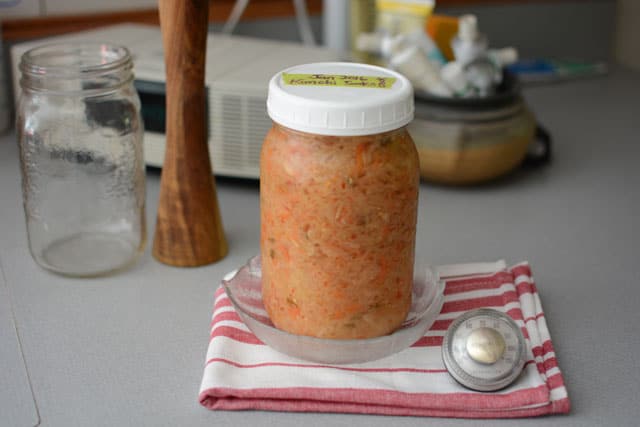
Until you get to know the temperatures in your home for the time of year you’re fermenting, it doesn’t hurt to actually take a temperature reading for the area where your sauerkraut in fermenting.
I have a household thermometer that I keep on the counter close to my fermenting jars. I find it useful to periodically glance at it and make sure the house is not too warm or too cold.
Place your thermometer where you think you will be fermenting and let it sit for 12-24 hours to get an accurate idea of the average temperature in that area. Stay away from areas that might have large temperature swings.
Depending on the type of thermometer you have, there are a couple different ways to do this.
Thermometer in Jar of Water
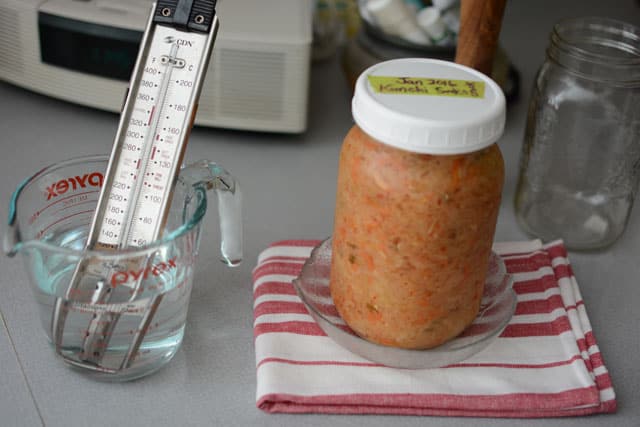
A thermometer in a measuring cup or jar of water placed where you’re fermenting is a simple way to get an accurate temperature reading.
Strip Thermometer
Inexpensive strip thermometers can be placed on the counter or taped to your jar to check temperatures. Beer and Kombucha brewers use these strips attached to their kegs or jars to monitor temperatures.
Even though strip thermometers come with adhesive backing, I recommend either temporarily taping it to your jar or just leaving it sitting on the counter next to your jar so it can be reused indefinitely.
Travel Alarm Clock with Thermometer
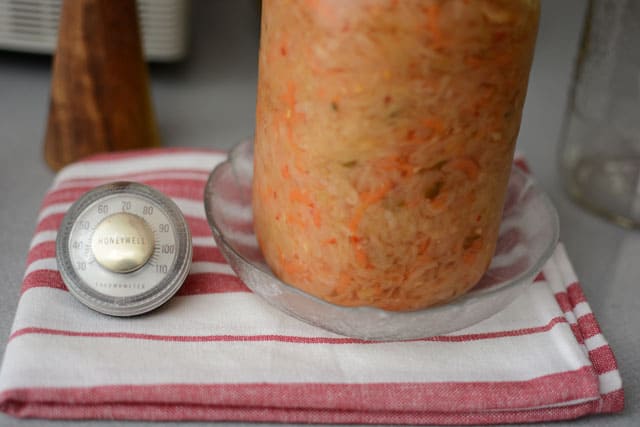
Most travel alarms come with thermometers. I’m lucky to have a vintage Honeywell thermometer that belonged to my husband’s family that serves the same purpose.
Just leave a thermometer on the counter near your jars of sauerkraut.
Fermentation Tips for Hot Weather
If your home is too warm, above 75°F (24°C), try one or more of the following fermentation tips for hot weather. Or, consider these bonus tips from my readers:
Take a look at the thermostat. Mostly there is a preset screw hidden somewhere. Screw in or out (depending on the thermostat) a couple of turns and check for the result.
The double door fridge that I use for fermenting and storage of green bananas now reaches a level of 18 C.
Ideal for cooling red wine… or fermenting sauerkraut!
I now refer to it as my “cellar.” Yes, it’s marvelous! I do wish it would have a setting to go warmer than 66 degrees (F), but hey, it works! A cooler ferment takes a bit longer but tastes better anyway. Just did a batch of kraut last night, can’t wait….
P.S. If you want to use 2-quart bottles with an airlock, this was the only one I could find (Magic Chef – Model # MCWC12B). I can fit 4 of them with about 1/4″ space from the top of the airlock. Just enough room to breath! Works great. http://www.homedepot.com/p/Magic-Chef-12-Bottle-Wine-Cooler-in-Black-MCWC12B/204997292
I placed my vegetables in a bush where it is safe from the heat and left it to ferment. It came out perfect. It actually tasted better than when it was inside the house. Just as the penguins use volcanoes for heat. So also in nature are there many things that provide a remedy when some element deems it necessary.
Just as the penguins use volcanoes for heat. So also in nature are there many things that provide a remedy when some element deems it necessary.
Slightly Increase the Amount of Salt Used
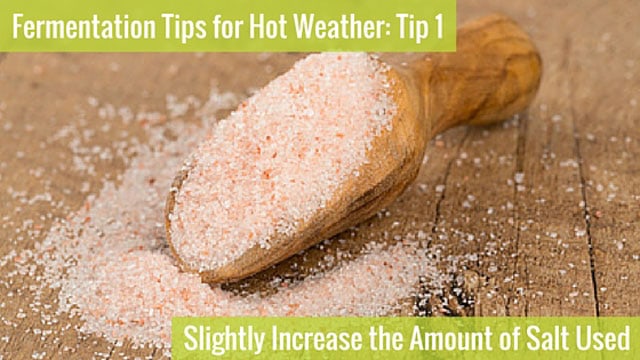
You can slightly increase the amount of salt used to slow down the fermentation a bit. Be aware, however, that too much salt will inhibit good bacteria so don’t go overboard.
Try a rounded tablespoon instead of a level tablespoon when measuring. If you’re weighing salt, test a batch with 2.5% instead of 2%.
How much salt you use and which salt you use makes a difference.
What is the Best Salt to Use When Making Fermented Sauerkraut?
How Much Salt Do I Use to Make Sauerkraut?
2Ferment for a Shorter Time Period

During ideal temperature conditions, 3-4 weeks is the normal length of time to ferment.
During hot weather, your ferment can be done in as little as 5 days. Check it at this point to see if it has fermented to your liking. If it has, put it in your refrigerator. If not, taste again in a few more days.
Ideally, however, we’re going to find – or make – a cooler spot for your ferment so it can properly progress through all three stages of fermentation.
Read more about how long to ferment sauerkraut:
How Long to Ferment Sauerkraut?
3Find a Cooler Location
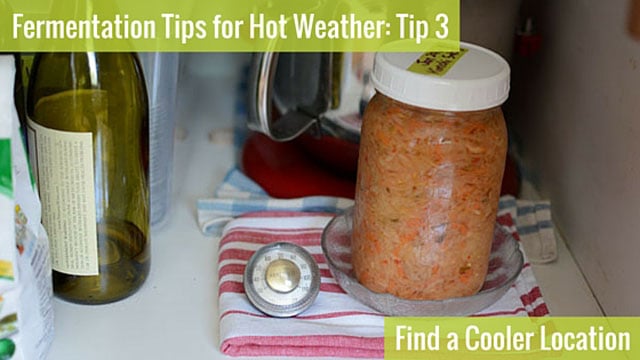
Survey your home for a better spot. You might be pleasantly surprised to find a little microclimate in your home that will do the trick, which is why a thermometer is so helpful.
You will want a spot away from sunlight and heat-producing appliances. That refrigerator or gas stove with pilot light produces more heat than you realize.
- Garage?
- Basement?
- Unused spare room?
- A low cupboard along an inside wall?
- Old dorm-sized refrigerator?
Turn the thermostat to its warmest setting and monitor with a thermometer to ensure it is not below 60° F (16° C).
And, don’t place your ferment in here until after the first few days of fermentation when you want a 65-72° F (18–22° C) temperature range.
Be careful with these out of the way locations, though. It’s easy to forget your ferment when it’s tucked away. Out of sight, out of mind.
As a reminder, leave an empty jar in plain sight in your kitchen with a note on it: “Check My Sauerkraut!”
4Use the Air Conditioner or a Fan
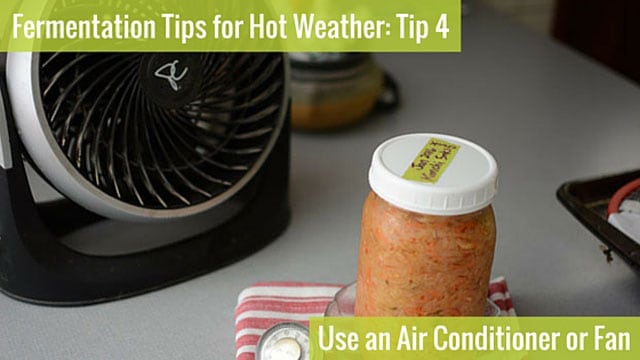
If your home is air-conditioned, it should be cool enough. If not, check a spot close to the air conditioner
Or, place a fan near your ferment. Moving air through a room will lower the temperature.
5Take Advantage of Evaporative Cooling: The Wet T-Shirt Method

For the wet t-shirt method, wrap your jar in a wet towel or t-shirt to take advantage of evaporative cooling.
The Brew: How to Home Brew Beer Magazine website goes into greater detail on how to use the wet t-shirt method.
Wet T-Shirt Method
“If you don’t have the room or the budget for a brewing fridge, there is a low-tech way of cooling your ferment. If you place a wet T-shirt over the ferment, it will cool down the wort inside the ferment. The wet T-shirt method works because as water evaporates from the T-shirt, heat goes with it. To keep the T-shirt wet, set a pan of water next to the ferment and dip part of the shirt in the water. As water evaporates from the shirt, water from the glass will wick up to replace it.”
“You can increase the cooling power of the T-shirt method by pointing a fan at the ferment. The air flowing past the ferment displaces the air next to the ferment. This air, laden with water vapor from evaporation, is replaced by drier air. This allows further water to evaporate from the T-shirt. And, of course, you can always add ice to the water pan.”
6Insulate Your Ferment

Wrap you ferment with an old sweater or piece of wool blanket. This can be a bit messy however if brine seeps out of the jar. You’ll have to wash the sweater or blanket afterward.
Yemoos Nourishing Cultures sells wool jar insulators. Stylish and handmade in the United States. You can even go DIY and make your own. Cut off a sleeve from an old wool sweater to slip over your jar of fermenting sauerkraut.
7Use an Ice Chest to Make a Cool Chamber
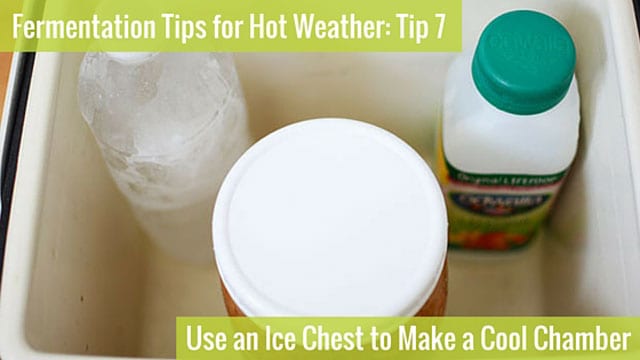
Use an ice chest filled with a few small juice-sized bottles of ice. Monitor the temperature in there. You don’t want to use too much ice and end up with it being too cold.
Place the ice next to but not directly touching your fermenting sauerkraut.
Use an Ice Chest to Make a Swamp Cooler
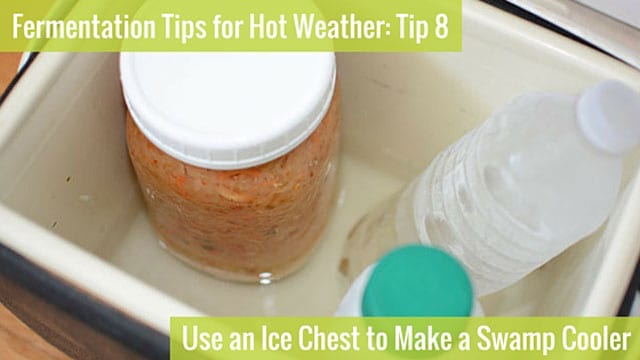
Place your jar of sauerkraut in a cooler filled with water 1/4 to 1/3 of the way up your jars. Throw cold packs or jugs of ice in the water. Change out your cold packs or jugs 1-2 times a day.
9Set Your Ferment on a Slab of Stone or Marble
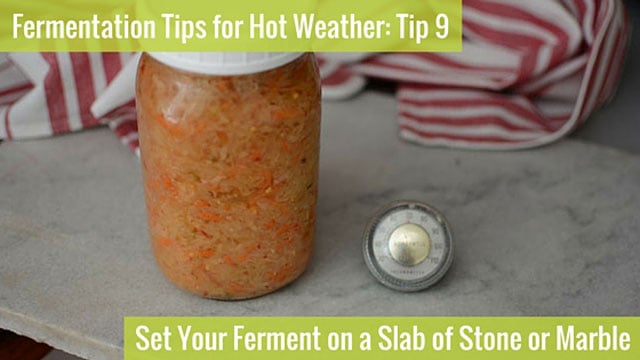
A marble or stone slab stays cool for a long time which is why they’re used to temper chocolate – in my household! – or are used by bakers when rolling out the butter-rich dough.
You can purchase a slab at a tile store or at a shop where they make marble or stone countertops. You might even luck out and get an odd sized, or “defective” piece on the cheap. Place the slab in your refrigerator at night to chill it and used in during the day to place under your jar of fermenting sauerkraut.
10Ferment Seasonally

You may have to work your way up to this one. I did.
When first learning to make sauerkraut, I fermented as I needed to and when I could find the time. I didn’t care if it was the middle of summer or if we were deep into winter. When one jar was about half eaten, I would start another jar fermenting.
Then I progressed to fermenting in a 10-liter crock, starting a new batch when there was just a jar or two of sauerkraut left. Again, the time of year didn’t matter.
Lastly, I moved to an area where my local farmer’s market had plenty of fall cabbage and switched to fermenting only during the fall and early winter.
What a wonderful way to be motivated to put up the bounty. The fresh cabbage produced all the brine needed. Prices for cabbage were good. The cabbage wasn’t shipped hundreds of miles and I was soon able to convince the farmers I got to know to grow the varieties of cabbage that make superior sauerkraut.
A winning combination.
11Avoid the Use of Starter Cultures
I’ve seen recommendations to use starter cultures when fermenting in hot weather. I recommend against using them. In my experience, I find they speed up the fermentation process, exactly opposite of what we’re trying to do. This happens because you’re adding more bacteria than is necessary.
These fermentation tips should get you started on cooling down your fermenting sauerkraut. Share your successes, failures or ideas in the Comment Section, below.
Last update on 2024-04-18 / Affiliate links / Images from Amazon Product Advertising API



 This post may contain affiliate links which won’t change your price but will share some commission.
This post may contain affiliate links which won’t change your price but will share some commission.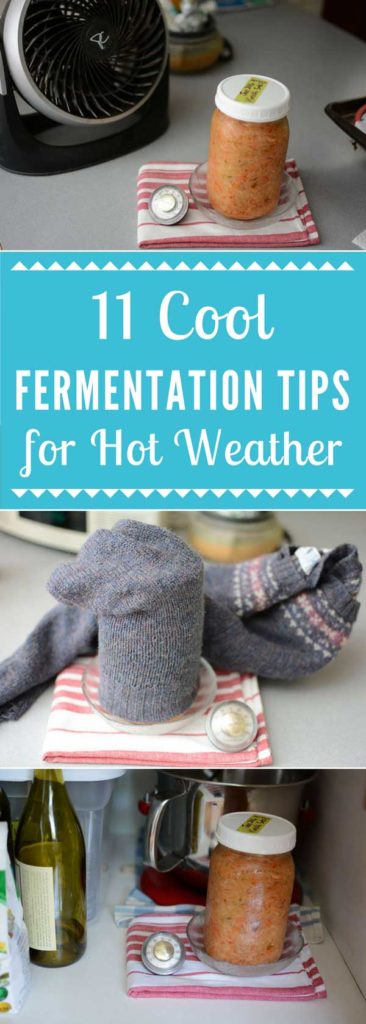



I’m most familiar with the seasonal technique. Our summers are hot and humid. I made my “last” crock of kraut in February and, due to an illness and surgery, let it go for two months. I thought it was ruined, but it was great. Just the top half inch was mushy. We’re still enjoying it from a large repurposed pickle jar. However, we plan to build an addition to the house, and I want to include a special space under the floor for fermenting sauerkraut all year ’round. Any suggestions on materials or construction?
Glad to hear that “ruined” crock turned out great! Just shows how flexible fermentation can be.
Lucky you, a place designed just for fermentation. I haven’t had to deal with hot and humid weather, myself. But, I would recommend reading up on “Root Cellars” and perhaps the Korean’s and their Kimchi, which is buried in crocks in the ground for fermentation. That should get you pointed in the right direction.
Be sure to share any of your tricks for fermenting in hot and humid weather. My readers would appreciate your experience.
I just came across your site and have signed up for the newsletter. I never liked sauerkraut as a kid but, one day a friend of mine insisted I taste a sauerkraut she had made and it was nothing like the sauerkraut I had as a kid. I loved it!! She taught me how to make it and have been doing it for about two years now. There definitely is a learning curve and you know you have it down when you begin to concern yourself with the well being of the organisms you are growing in the fermentation process. My one question is this. Is there a sodium level meter available to determine salinity? How do you measure out a 2 to 2.5 percent sodium. I notice that depending on what type of salt I use, I have to first determine how salty that salt is. I know it sounds crazy but not all tablespoons of salt have the same amount of sodium. Maybe I am wrong but that has been my experience. I have learned to taste the brine an hour after I have it in the crock, to determine if I want to add more salt or more cabbage. If I add either, I wait another hour and taste the brine again. I do have many more questions and look forward to receiving your newsletter.
Thank you much.
Hello Duel, I also never liked sauerkraut as a kid, but that canned flavorless stuff is very different. Glad to hear you go to taste the real stuff! “The well-being of the organisms you are growing.” What a wonderful to put it. Made for a good laugh. Thank you!
Sodium level and meter? No meter I know of, but since there is a range of salinity that works for fermentation, I haven’t concerned myself with testing salinity levels. Weighing the cabbage seems to do the trick. You can also weigh the salt and that’s in my last paragraph here.
Yes, you are right, the sodium content of salts will vary from a processed salt being close to 99% sodium to the mineral-rich salts (Pink Himalayan and Real Salt) being more like 84%. I used to teach adding salt by taste, but what tastes salty to one person will not to the next (Has to do with the health of your adrenal glands – they need minerals/salt all will crave it if they are stressed.).
I’ve been fermenting just with Himalayan Pink and need to do an experiment with a 99% sodium, just for “taste” is not anything else. I think people who complain about sauerkraut being too salty are using a 99% sodium salt.
So, if you have a scale you can set to grams, just multiply the weight by 2% (or 2.5%) and add that much salt. So, 800 grams cabbage (including anything else you flavor it with) x .02 = 16.00, which means you need 16 grams of salt. Get to know your salts and what percent 2% or 2.5% you like.
Hello Ms. Holly, and thank you for your response. I just noticed your reply and am delighted by all the efforts you’ve gone thru to clarify the percent of sodium content of different salts. I wasn’t sure if anyone had asked the question, so I put it forth.
Just yesterday, I was reading you last blog, in which you provide great guidance regarding salt and felt that my letter to you had perhaps motivated you to speak to this very important issue. I had a big smile on my face.
I have been making sauerkraut for about 3 years and have learned much. I make 15 liters at a time for my family, friends and neighbors. I generally use celery root, caraway or dill to flavor the krauts and for my birthday, my spouse gave me a culinary mandoline from Poland and all the accessories; the heart coring tool, stomper, wooden jarring scissors.
I will chime in from time to time to let youse know how my living foods are coming along.
Thank you again for you reply and may you have a good day.
Alvaro Vega
Hello Alvaro, Yes your question got me thinking and motivated me to set the record straight. Glad to put a smile on your face!
And to take it one step further… not only is the sodium in mineral-rich salt at 84% but also the mineral component of our blood matches that of unprocessed salts/mineral-rich salts; 84%. Which, according to notes taken while listening to a podcast years ago by Dr Cowan, author of FourFold Path to Healing. He said that IF high blood pressure is related to salt consumption then that would be from pure sodium salts, not from mineral-rich salts. Another reason to put out the money for the good stuff.
You have some lucky family and friends. Keep on sharing the goodness.
Thanks for the great tips Holly. I found digital room thermometers for $10 on amazon that track max/min temperature over time. And I could not find a place in my apartment that doesn’t go above 70 degrees.
But I didn’t think about putting the jars in a cooler or wrapping them with wet fabric. Great ideas that I don’t know why I didn’t think off. Note that in #4, not sure a fan will cool down a jar much unless it has condensation on it (which it does in #5 of course). We feel cool with a fan because we sweat but it won’t cool an object or a room (just feels like that way to us).
Thanks for great tips and explanation of the three different fermentation stages. I’ve been stopping my ferment way too soon.
GREAT tip on the min/max digital room thermometers. I’ll add it to the post. Yes, you’re probably right about the fan without condensation… Thank YOU
Thank you a million times for this article. I have searched all over the Internet for this information you posted! I’ve spent over 6 months trying to figure out why my ferments are turning brown. I live in
Cocoa Beach , Florida and it’s just not cold enough in my house to keep my ferments happy and healthy. I so desperately need them for all the probiotics. I’m trying to heal a severe case of leaky gut. I think that once I have some true fermented suarkraut , that I will see some improvements in my health. I have wasted at least $300-$500 dollars on organic cabbage and different containers and kept thinking it was the containers that were not working. Now I know that it is the heat. It’s usually 78-80 degrees in our house during the summer. So I guess I’m going to have to buy a small fridge for the garage so I can store my fermenting saurkraut. Are you able to tell me, if I set the fridge at 70degrees, would that be the best temperature ? Again I thank you for all this very important information! ? If anyone out there lives in central Florida and ferments in the summer, please let me know how you do it and for how long. Thanks!
You are SOOO welcome. Glad to be able to help solve a few mysteries and fingers crossed for healing that leaky gut.
A fridge for fermenting? Cool idea. Ideally, I would ferment for 3 days at 70 and then drop to 65 for a few weeks. Check on your first few batches to make sure all goes smoothly. Or, if you’re adding jars and don’t want to fiddle with the temp, just at 68 for the entire time.
If you’re fermenting without the cooler fridge, a short 5 days should do it. But, with health conditions I would go for the longer ferment. Best of luck.
Hi Holly I have the same issue. I cannot find a figure that get than warm the best i could find was 66 degrees that was the warmest it will go. Any Frig suggestions, I’ve looked.
Thanks Steve